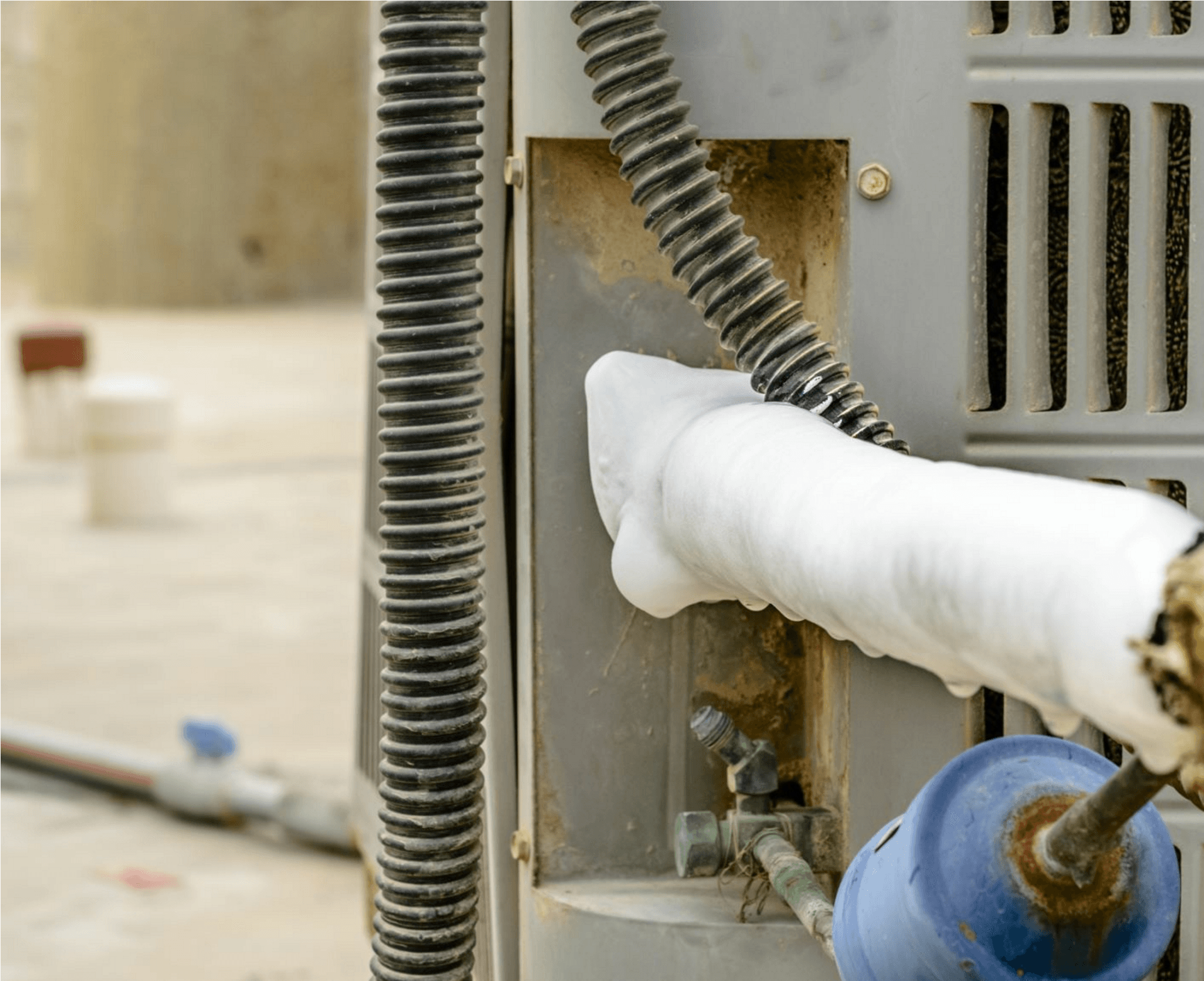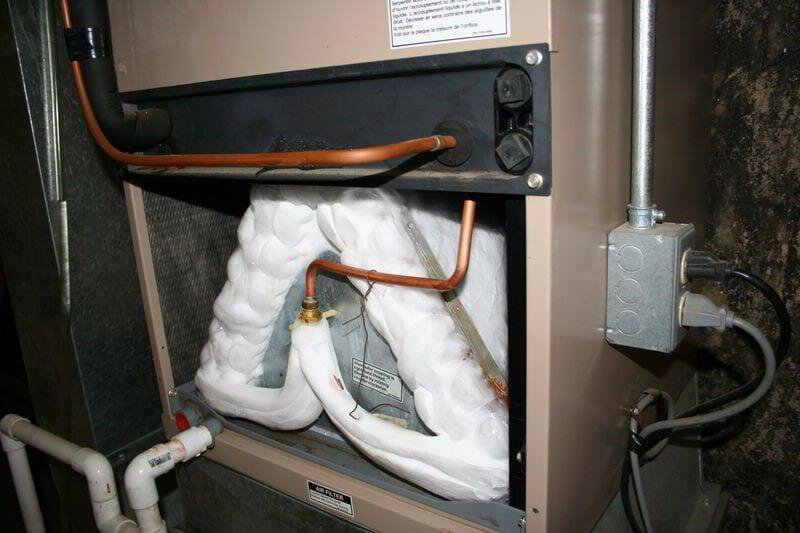The article author is making several good annotation related to Why Is Ice On My Outside Air Conditione in general in the article in the next paragraphs.

Introduction
Finding that your air conditioner pipe is iced up can be worrying, specifically during warm summertime when you depend on your ac system one of the most. Recognizing what to do in such a situation is vital to prevent further damages to your air conditioning system and guarantee your comfort indoors.
Recognizing the Causes
A number of variables can contribute to the freezing of an a/c pipeline. Recognizing these reasons can help you deal with the problem properly.
Absence of Airflow
One common reason for a frozen a/c pipeline is inadequate air flow. When the air movement over the evaporator coil is limited, it can create the coil to go down below freezing temperature, resulting in ice formation on the pipeline.
Reduced Refrigerant Levels
Not enough cooling agent levels in your air conditioner system can additionally result in a frozen pipe. Low refrigerant levels can trigger the stress in the system to drop, leading to the cold of wetness on the evaporator coil.
Winter Conditions
In chillier environments, freezing temperatures outside can contribute to the freezing of air conditioning pipes. If your air conditioning unit is not correctly shielded or if there are leakages in the ductwork, chilly air can infiltrate the system, triggering the pipe to freeze.
Dirty Air Filters
Dirty or clogged air filters can limit air movement in your air conditioner system, resulting in various issues, consisting of an icy pipe. It's important to replace or clean your air filterings system regularly to ensure correct airflow and protect against ice build-up.
Indications of a Frozen Air Conditioning Pipe
Recognizing the indicators of an icy a/c pipe is crucial for punctual activity.
Lowered Airflow
If you discover a significant decrease in air movement from your vents, it might indicate an icy pipeline.
Ice Buildup on the Pipe
Visible ice buildup on the cooling agent line or the evaporator coil is a clear indicator of a frozen air conditioner pipeline.
Odd Sounds from the Unit
Uncommon noises, such as hissing or bubbling, originating from your a/c unit can indicate that there's ice existing on the pipeline.
Immediate Actions to Take
When faced with an icy air conditioner pipe, it's important to act rapidly to prevent additional damage to your cooling system.
Switching off the a/c
The initial step is to switch off your air conditioning unit to stop the system from running and intensifying the concern.
Checking for Blockages
Evaluate the location around the indoor device for any blockages that may be blocking air movement, such as furniture or drapes.
Thawing the Pipe
You can make use of gentle approaches like placing towels taken in warm water around the frozen pipeline to help thaw it gradually.
Preventive Measures
Taking preventive measures can aid prevent future occurrences of an icy air conditioning pipeline.
When DIY Methods Fail
If your attempts to thaw the pipeline or address various other issues are not successful, it's time to hire a specialist.
Importance of Hiring a Professional HVAC Technician
A licensed HVAC technician has the proficiency and tools essential to diagnose and fix concerns with your AC system securely and properly.
Routine Maintenance Checks
Set up normal maintenance get in touch with a professional HVAC specialist to ensure that your AC system is running efficiently.
Transforming Air Filters
Regularly change or clean your air filters to prevent air movement constraints and keep optimal performance.
Insulating Exposed Pipes
If your air conditioner pipes are exposed to cool temperature levels, think about insulating them to prevent freezing throughout winter season.
Seeking Professional Help
If DIY methods stop working to deal with the issue or if you're uncertain about exactly how to proceed, it's finest to look for assistance from a qualified HVAC technician.
Conclusion
Handling a frozen air conditioning pipe can be an aggravating experience, however understanding how to react can assist reduce damage and restore comfort to your home. By recognizing the reasons, identifying the indications, and taking timely action, you can effectively deal with the problem and avoid future occurrences.
G UP? HOW TO FIX IT?
It happens all over America. And the rest of the world probably. It’s the hottest day ever and for some darn reason your AC isn’t cooling the house. You fiddle with the thermostat to try and fix the problem. Nada. All you can do now is go outside and check the AC unit. You make your way there and find your air conditioner unit is frozen! But how?
In this post we’ll cover how you can tell that your air conditioner has frozen (other than the obvious reasons), what could have caused the freeze, and some of the things you can do about your AC freezing up. And if you have a frozen heat pump condenser, read our blog about it to learn what to do! But remember, it is always best to avoid your AC freezing up with an AC tune up. And if you are moving into a home, it's critical to get HVAC inspection so that you are aware of an AC problems before you move in.
Keep reading and you may be able to fix the frozen AC yourself. If you can’t, call an HVAC specialist. If you live in Maryland, call SuperTech HVAC for AC repair. We’ll take care of it.
How Does An Air Conditioning Unit Work?
How you probably imagine an AC works is wrong. Contrary to popular belief, an AC system does not inject cool air into a building. Instead, it removes the heat from inside and transfers it outside. Cool huh? (Pun intended).There are 4 major components among the 3 stations of an air conditioning system: the evaporator coil, the compressor, the condenser, and the refrigerant – a special chemical that links everything together through a closed loop system.
Station 1:
Warm indoor air is sucked into the return vent, through a filter, and blows over the evaporator coil. The heat is absorbed into the cold refrigerant, turning it from liquid to gas. The air, which is now cool, is blown back into the home to areas that your thermostat, i.e. you, has decided.
Station 2:
The refrigerant makes its way outside the house to the compressor, which squeezes the warm refrigerant, raising its gaseous temperature even more.
Station 3:
When the super hot vapor refrigerant reaches the condenser, the last step, the heat is expelled and absorbed into the outdoor air. The refrigerant instantly cools, which changes it from gas back to liquid form. The cold liquid refrigerant is now ready to return to station 1 and repeat the process.
Is Your AC Freezing Up? Here Are The Signs:
As you may have guessed, your air conditioner unit freezing up on a hot day is not normal.
If this happens, there's no need to panic. Often the issue can be solved with a little troubleshooting. If the AC unit is left frozen for too long however, you may find yourself with a bigger problem.
First things first, how do you know your AC is frozen?
Well, the obvious sign is the ice on your refrigerant line-set pipe. Simply check between your outdoor AC unit and your home's exterior wall to see whether your AC line frozen.
You might also have a frozen evaporator coil. This one's not as easy to check. You'll need to open a panel on the indoor unit to inspect. Don't do this unless you're handy. If you aren't, call an HVAC pro like SuperTech HVAC or you may damage something in the process.

I hope you liked our excerpt on How can I fix an air conditioner’s frozen pipe?. Thanks for taking a few minutes to read our posting. Enjoyed our posting? Please share it. Help someone else find it. I thank you for reading our article about What Do I Do If My AC Pipe Is Frozen.
Check This Out